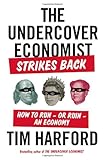But this 'floor' only accounts for, say, 3% of the price of gold. Whatever makes the remaining 97% a reliable store of value could also provide Bitcoin with 100% of its store of value.
A similar point comes from Tim Harford's fascinating description of the currency used on the Pacific island of Yap:
------------------------
Oddly enough, there is a near real-world equivalent to the Ningi, the triangular rubber coin larger than Mars dreamed up by the humorist Douglas Adams. It can be found on the island of Yap, in Micronesia in the West Pacific. Their coins, the rai, are stone wheels with a hole in the middle. Some are fairly portable a handspan or less across, and the weight of a couple of bags of sugar. But the most valued stones are far bigger - one British sailor wrote in the late nineteenth century of a stone wheel that was four and a half tons in weight and over nine feet in diameter. In other words, it was almost completely immovable.
Yap’s stone money used to be a serious business. The stones were quarried and carved on the island of Palau, 250 miles away One Victorian naturalist witnessed four hundred men from Yap, a tenth of the adult male population, at work in the quarries of Palau. Getting the stones from Palau to Yap on a little bamboo boat was a difficult and sometimes lethal affair - some of them weighed as much as two cars. (And rai were especially valuable if someone had died on the expedition to fetch them.) The biggest stones might have been used for major transactions such as buying land or wives; more modestly sized stones - a couple of feet across - were exchangeable for a pig. Even then, it would have been a lot easier to move the pig than to move the stone.
All this meant that for purely practical reasons, the Yap islanders had to develop an important monetary innovation: they divorced ownership of the stone from physical control of the object. If you wanted to buy my pig, that transaction would be publicly witnessed: I’d give you the pig and in exchange, you’d transfer ownership of one of your stones - the one leaning against the tree, second on the left behind your hut. Now everybody would know that that particular stone was Tim’s stone. You and I wouldn’t have to go to the trouble of actually moving the thing. One day, a crew from the quarries were bringing a new large stone from Palau when they ran into a storm not far from the coast of Yap. The stone sank while the men swam to shore to tell the tale of their lucky escape and their loss. But of course, if the stone propped up outside your hut doesn’t need to move around to change ownership, why should the stone at the bottom of the sea be any different? This giant stone on the seabed had an owner - the chief who had sponsored the expedition to get it. And now his ownership could be transferred to another rich islander, and then to another, just as with any other stone. It was perfectly good money, even though it was out of sight and out of reach.
------------------------
From "The Undercover Economist Strikes Back" by Tim Harford: http://www.amazon.com/Undercover-Economist-Strikes-Back-Ruin...


It's hard to rectify that in a quick comment though, as it's a complicated, interesting and fascinating subject.
Just to pick one thing, you mention 'efficiency'. Capitalism is not very efficient in a lot of ways. However, it happens to be more efficient for large groups of people than all the other systems people have tried, if you don't mind me poaching Churchill's quote about democracy.
And another: money. Money is merely a means of trading scarce goods. Looking at it as a problem is a red herring. The actual problem is the availability and distribution of scarce resources like food and shelter and iphones and other things people want.
Here's a book I'm fond of - it's fairly mainstream economics.
http://www.amazon.com/The-Undercover-Economist-Tim-Harford/d...
He's written another one lately about macroeconomics which is pretty good as well:
http://www.amazon.com/The-Undercover-Economist-Strikes-Back/...